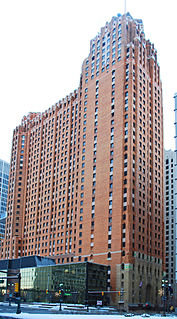
The American Legion Memorial Bridge is a reinforced concrete arch bridge carrying South Cass Street over the Boardman River in Traverse City, Michigan. It was completed in 1930 and listed on the National Register of Historic Places in 2000.

The Tower Bridge is a Vertical lift bridge across the Sacramento River, linking West Sacramento in Yolo County to the west, with the capital of California, Sacramento, in Sacramento County to the east. It was previously a part of U.S. Route 40 until that highway was truncated to east of Salt Lake City. The bridge is maintained by the California Department of Transportation as part of State Route 275 and connects West Capitol Avenue and Tower Bridge Gateway in West Sacramento with the Capitol Mall in Sacramento.

The Lamar Boulevard Bridge is a historic arch bridge carrying Texas State Highway Loop 343 over Lady Bird Lake in downtown Austin, Texas, United States. The bridge features six open-spandrel concrete arches spanning 659 feet (201 m) and carries tens of thousands of vehicles daily across the lake. Completed in 1942, the Lamar Boulevard Bridge was the second permanent bridge to cross the Colorado River, and one of the last Art Deco-style open-spandrel concrete arch bridges built in Texas. The bridge was named an Austin Landmark in 1993 and added to the National Register of Historic Places in 1994.

The Antietam Avenue Bridge was located where Antietam Avenue passed over the Dequindre Cut in Detroit, Michigan. It has been demolished due to structural deficiencies and will be reconstructed. The original bridge was listed on the National Register of Historic Places in 2000.
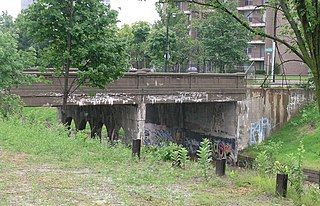
The Chestnut Street Bridge is located where Chestnut Street passes over the Dequindre Cut in Detroit, Michigan. It was listed on the National Register of Historic Places in 2000.

The Fort Street–Pleasant Street and Norfolk & Western Railroad Viaduct is a bridge carrying six lanes of Fort Street over both Pleasant Street and multiple tracks comprising the Norfolk Southern Railway Detroit District and Conrail Shared Assets Lincoln Secondary and Junction Yard Secondary lines on the border of the Boynton and Oakwood Heights neighborhoods in Detroit, Michigan, just west of the Rouge River. It was listed on the National Register of Historic Places in 2000. The bridge underwent massive repairs and other construction in late 2010 and throughout much of 2011, which included narrowing the Fort Street boulevard north of the viaduct into a six-lane undivided road with a left-turns-only lane.

The Cornwall Bridge is a two-lane, concrete arch bridge carrying U.S. Route 7/Connecticut Route 4 over the Housatonic River and the Housatonic Railroad in Northwestern Connecticut. It was built in 1930 by C.W. Blakeslee and Sons for the Connecticut Highway Department and consists of 6 open-spandrel arches spanning 674 feet (205 m), and is a fairly large example of concrete open-spandrel construction. The bridge was reconstructed in 1994 and was listed on the National Register of Historic Places in 2004.

The South Union Street–Boardman River Bridge is a bridge located on South Union Street over the Boardman River in Traverse City, Michigan. It was listed on the National Register of Historic Places in 2000.

The Old M-94–Au Train River Bridge is a bridge located on Wolkoff Road over the Au Train River in Au Train Township, Michigan. It was listed on the National Register of Historic Places in 1999, and is significant because it is one of only two remaining bridges built to an early 20th-century Michigan State Highway Department design standard.

The Main Street–Black River Bridge is a bridge located on Main Street over the Black River in Ramsay, Bessemer Township, Michigan. It was listed on the National Register of Historic Places in 1999.
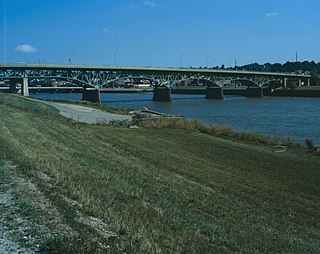
The Jefferson Street Viaduct is an historic structure located in Ottumwa, Iowa, United States. The riveted Warren deck truss bridge was completed in 1936. It was listed on the National Register of Historic Places in 1998 as a part of the Highway Bridges of Iowa MPS.
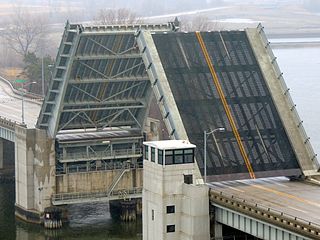
The Blossomland Bridge is a bascule bridge in St. Joseph, Michigan, that carries M-63 across the St. Joseph River. Delayed by World War II, construction took place from 1947 though 1948. At the time, it was the longest bridge built by the Michigan State Highway Department. The bridge is listed on the National Register of Historic Places.

The Cheboygan Bascule Bridge, also known as the State Street Bridge, is a double-leaf bascule bridge in Cheboygan, Michigan, carrying U.S. Highway 23 across the Cheboygan River. Built in 1940, it was the last bascule bridge constructed in the state of Michigan prior to the end of World War II. It replaced an aging swing bridge built in 1877. The bridge is listed on the National Register of Historic Places.

The US-12–Coldwater River Bridge was a road bridge carrying Old US-12 over the Coldwater River in Coldwater, Michigan. It was listed on the National Register of Historic Places in 1999.

The West Sixth Street Bridge is a historic stone arch bridge in downtown Austin, Texas. Built in 1887, the bridge is one of the state's oldest masonry arch bridges. It is located at the site of the first bridge in Austin, carrying Sixth Street across Shoal Creek to link the western and central parts of the old city. The bridge was added to the National Register of Historic Places in 2014.
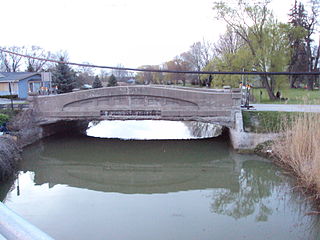
The Vernier Street–Swan Creek Bridge was a historic bridge carrying Vernier Street over Swan Creek in Ira Township, Michigan. It was listed on the National Register of Historic Places in 2000. It was at one time one of the oldest remaining curved-chord though girder bridges, a design unique to the state of Michigan. The bridge was demolished in 2014.
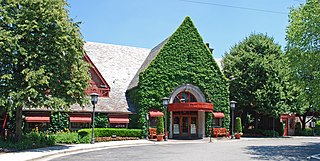
The Grand Trunk Western Railroad Birmingham Depot is a former railroad train station located at 245 South Eton Street in Birmingham, Michigan. It was listed on the National Register of Historic Places in 1985. As of 2018, the Big Rock Chophouse restaurant occupies the building.

The Trowbridge Road-Grand Trunk Western Railroad Bridge is a bridge carrying Trowbridge Road over the Grand Trunk Western Railroad in Bloomfield Hills, Michigan. It was listed on the National Register of Historic Places in 2000.

The Ash Street-Sycamore Creek Bridge is a historic bridge located on Ash Street (MI-36) over Sycamore Creek in Mason, Michigan. It was listed on the National Register of Historic Places in 1999. It is one of the oldest T-beam bridges in Michigan.
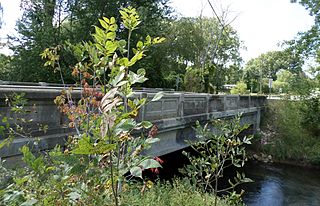
The M-50–Sandstone Creek Bridge, also known as th Tompkins Bridge, is a road bridge carrying M-50 over Sandstone Creek in Tompkins Township, Michigan. It was listed on the National Register of Historic Places in 2000.






